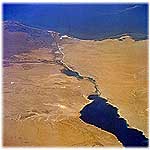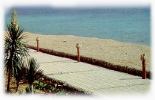|
Suez (El-Suweis) is
located on the Southern tip of the Suez Canal, and
has been a commercial port since the 7th century.
The spice trade and pilgrimages to Mecca made it
prosperous throughout the Middle Ages. It became a
naval base in the 15th century and, in 1869, the
opening of the Suez Canal ensured its development
as a modern city. Today, Suez is one of Egypt's
largest ports. It is situated near the scenic
Ataga Hills (Jebel Ataga), about 134 kilometers
(83 miles) from Cairo and 88 kilometers (55 miles)
from Ismailia, this city affords an excellent view
of Sinai and the Red Sea. It is also interesting
to watch ships passing through the Canal form
Suez's vantage point.
The Suez Canal
 There
seems to have always been interest in a link
between the Mediterranean and Red Seas. Most of
the early efforts were directed towards a link
from the Nile to the Red Sea. Strabo and Pliny
record that the earliest effort was directed by
Senwosret I, but no evidence that there was an
actual canal built exists.
Under Necho II (610-595 BC) a canal was built
between the Pelusian branch of the Nile and the
northern end of the Bitter Lakes (which lie
between the two seas) as a cost of, reportedly,
100,000 lives. Over many years, the canal fell
into disrepair, only to be extended, abandoned,
and rebuilt again. After having been neglected, it
was rebuilt by the Prusian ruler, Darius I
(522-486 BC), who's canal can still be seen along
the Wadi Tumilat. It was extended to the Red Sea
by Ptolemy II Philadelphus (285-246 BC), abandoned
during the early Roman rule, but rebuilt again by
Trajan (98-117 AD) Over the next several
centuries, it once again was abandoned and
sometimes dredged by various rulers for various
but limited purposes. Amr Ibn el-As rebuilt the
canal after the Islamic takeover of Egypt creating
a new supply line from Cairo, but in 767 AD, the
Abbasid caliph El-Mansur closed the canal a final
time to cut off supplies to insurgents located in
the Delta. There
seems to have always been interest in a link
between the Mediterranean and Red Seas. Most of
the early efforts were directed towards a link
from the Nile to the Red Sea. Strabo and Pliny
record that the earliest effort was directed by
Senwosret I, but no evidence that there was an
actual canal built exists.
Under Necho II (610-595 BC) a canal was built
between the Pelusian branch of the Nile and the
northern end of the Bitter Lakes (which lie
between the two seas) as a cost of, reportedly,
100,000 lives. Over many years, the canal fell
into disrepair, only to be extended, abandoned,
and rebuilt again. After having been neglected, it
was rebuilt by the Prusian ruler, Darius I
(522-486 BC), who's canal can still be seen along
the Wadi Tumilat. It was extended to the Red Sea
by Ptolemy II Philadelphus (285-246 BC), abandoned
during the early Roman rule, but rebuilt again by
Trajan (98-117 AD) Over the next several
centuries, it once again was abandoned and
sometimes dredged by various rulers for various
but limited purposes. Amr Ibn el-As rebuilt the
canal after the Islamic takeover of Egypt creating
a new supply line from Cairo, but in 767 AD, the
Abbasid caliph El-Mansur closed the canal a final
time to cut off supplies to insurgents located in
the Delta.
The famous Canal is one of the greatest
engineering feats of modern record. The pilot
study estimated that a total of 2,613 million
cubic feet of earth would have to be moved,
including 600 million on land, and another 2,013
million dredged from water. The total original
cost estimate was two hundred million francs. The
canal stretches over 100 miles from Port Said and
the Mediterranean Sea to Suez and the Red Sea and,
along with other such projects, changed the face
of maritime world trade.
The first efforts to build a modern canal came
from the Egypt Expedition of Napoleon Bonaparte,
who hoped the project would create a devastating
trade problem for the English. Though this project
was begun in 1799 by Charles Le Pere, a
miscalculation estimated that the levels between
the Mediterranean Sea and the Read Sea were too
great and work was quickly suspended.
However, in 1833, a group of French intellectuals
known as the Saint-Simoniens arived in Cairo and
were very interested in the Suez project despite
such problems as the difference in sea levels.
Unfortunately, at that time Mohammed Ali had
little interest in the project, and in 1835, the
Saint-Simoniens were devastated by a plague
epidemic and most of the twenty or so engineers
returned to France. They did leave behind several
enthusiasts for the canal, including Ferdinand de
Lesseps (who was then the French vice-consul in
Alexandria) and Linant de Bellefonds.
In Paris, the Saint-Simoniens created an
association in 1846 to study the possibility of
the Suez Canal once again. In 1847, Bourdaloue
confirmed that there was no real difference in the
levels between the Mediterranean and Red Seas, and
it was Linant de Bellefonds that drew up the
technical report. Unfortunately, there was
considerable British opposition to the project,
and Mohammed Ali, who was ill by this time, was
less than enthusiastic.
Work
finally began on the canal in 1859 near Port Said.
Pasha Said was very open to European influence,
and in fact, was a childhood friend of Ferdinand
De Lesseps, who founded the Universal Company of
the Suez ( and built the Canal). After the company
ran into financial problems, it was also Pasha
Said who purchased 44 percent of the company to
keep it in operation. However, the British and
Turks were concerned with the venture and managed
to have work suspended for a short time, until the
intervention of Napoleon III. Between 1860 and
1862, the first part of the canal was completed.
However, after Ismail succeeded Pasha Said in
1863, the work was again suspended. After
Ferdinand De Lesseps again appealed to Napoleon
III, an international commission was formed in
March of 1864. The commission resolved the
problems and within three years, the canal was
completed. On November 17, 1869 the barrage of the
Suez plains reservoir was breached and waters of
the Mediterranean flowed into the Red Sea.
The completion of the Suez Canal was a cause for
considerable celebration. In Port Said, the
extravaganza began with fireworks and a ball
attended by six thousand people. They included
many heads of state, including the Empress
Eugenie, the Emperor of Austria, the Prince of
Wales, the Prince of Prussia and the Prince of the
Netherlands. Two convoys of ships entered the
canal from its southern and northern points and
met at Ismailia. Parties continued for weeks, and
the celebration also marked the opening of
Ismail's old Opera House in Cairo, which is now
gone.
Unfortunately between the Suez Crisis and later
wars, the canal was damaged extensively and was
not operated for several year after 1967. However,
on June 5th, 1975, the canal was again opened, and
since then has been updated and enlarged.
Suez
 Suez
(El-Suweis) is located on the Southern tip of the
Suez Canal, and has been a commercial port since
the 7th century. The spice trade and pilgrimages
to Mecca made it prosperous throughout the Middle
Ages. It became a naval base in the 15th century
and, in 1869, the opening of the Suez Canal
ensured its development as a modern city. Today,
Suez is one of Egypt's largest ports. It is
situated near the scenic Ataqa Hills (Jebel Ataqa),
about 134 kilometers (83 miles) from Cairo and 88
kilometers (55 miles) from Ismailia, this city
affords an excellent view of Sinai and the Red
Sea. It is also interesting to watch ships passing
through the Canal form Suez's vantage point. Suez
(El-Suweis) is located on the Southern tip of the
Suez Canal, and has been a commercial port since
the 7th century. The spice trade and pilgrimages
to Mecca made it prosperous throughout the Middle
Ages. It became a naval base in the 15th century
and, in 1869, the opening of the Suez Canal
ensured its development as a modern city. Today,
Suez is one of Egypt's largest ports. It is
situated near the scenic Ataqa Hills (Jebel Ataqa),
about 134 kilometers (83 miles) from Cairo and 88
kilometers (55 miles) from Ismailia, this city
affords an excellent view of Sinai and the Red
Sea. It is also interesting to watch ships passing
through the Canal form Suez's vantage point. |